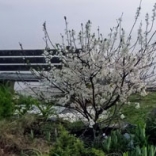Covering Ground
 Save the Stems: Pollinator Protection in Winter
Save the Stems: Pollinator Protection in Winter
Summer’s bright flowers and wavy grasses are dry and grey in winter. Many would say they’re not worthy of reprieve from autumn clean-ups.
But there’s another perspective circulating among folks who offer ways to protect pollinators. The idea is called “Save the Stems,” calling upon gardeners and landscapers to leave dead-head flowers standing until spring.
Why?
 Time to Rethink Invasive Plants
Time to Rethink Invasive Plants
As someone who works in the land care business, I sometimes feel as though I’m caught in an endless game of whack-a-mole. Between spotted lantern flies and jumping worms, from knotweed to tree-of-heaven, I sometimes think, who needs Halloween or a scary movie?
Is there are more systematic, less fatiguing way to think about the problem of invasive plants?
 Ten-plus Native Shrubs That Withstand Drought and Deer
Ten-plus Native Shrubs That Withstand Drought and Deer
Lots of us look for native plants that support pollinators and birds, but need those plants to be deer-resistant and tolerant to annual summer droughts. In my latest article, I nominate some selections that meet all three criteria—native, deer-resistant, and drought-tolerant. In my experience, these are the best natural bargains you can buy.
 Pollinator Protection Is Buzzing
Pollinator Protection Is Buzzing
It was 2019 when Heather Bradley accidentally killed a frog with her lawnmower.
"It hit me that keeping a turf lawn was a total waste of time, space, and resources, not to mention a detriment to ecology and the environment," said Bradley.
 Plant Debris Overruns Transfer Stations
Plant Debris Overruns Transfer Stations
We cut and pull plants and branches to neaten and manage outdoor spaces. It arrives at brush dumps and town transfer stations. What happens next?
 After the Flowers Are Planted
After the Flowers Are Planted
Plastic pots do a great job of helping us bring home the beauty of plants. But what can we do with the pots?
In Connecticut, we can recycle green, white, and red pots. (Clean them out first, please.) This unfortunately leaves out all the black pots and trays, which are the majority.
 On Earth Day, Admiring the Work of Volunteers
On Earth Day, Admiring the Work of Volunteers
Once upon a time, I called a newspaper editor and inquired if she needed a garden column. She said they’d give me a try, and my regional column, Green & Growing, launched in February 2013. I started out imagining that I’d write veggie and flower garden how-to articles with an organic flair and a local bent.
 Where Do the Wild Things Grow?
Where Do the Wild Things Grow?
We know that native plants didn’t begin their evolution in the black plastic pots we see at garden centers. But where are the native plants in nature? How do we know if they are thriving or disappearing or just holding their own?
 5 Good Books for Nature's Sturdy Bookshelf
5 Good Books for Nature's Sturdy Bookshelf
Some of us are snowbirds in winter, but I am more of a book bird. To the extent that winter forces me indoors, I fly across the room to my bookshelf. Here’s a sample of recent books on ecology, land care, trees, and plants that I’ve found useful, informative, and entertaining.
 For Grown-ups Who Love to Play in the Dirt
For Grown-ups Who Love to Play in the Dirt
Holiday, 2021: The useful, earth-kind products described below are all have a special gleam of their own, having been invented, made, or packaged in Connecticut, notably free from gnarly supply chain woes. The products include the following:
